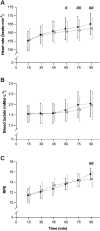Test-Retest Reliability of Running Economy and Other Physiological Parameters During 90 min of Running in Well-Trained Male Endurance Runners
- PMID: 40421635
- PMCID: PMC12107507
- DOI: 10.1111/sms.70080
Test-Retest Reliability of Running Economy and Other Physiological Parameters During 90 min of Running in Well-Trained Male Endurance Runners
Abstract
Running economy (RE) is highly reliable when measured in an unfatigued state; however, its reproducibility during prolonged exercise has not been investigated. RE is known to worsen during prolonged exercise (referred to as RE "durability"), and quantifying the reliability of RE durability measurements will determine our sensitivity to detect subtle differences between groups or conditions. This study aimed to assess the reliability of RE and other physiological parameters throughout a 90-min run in the heavy-intensity domain among well-trained runners. Fourteen male marathon runners (maximal oxygen uptake (V̇O2max): 63.1 ± 5.8 mL·kg-1·min-1; marathon time: 02:47 ± 00:10 h:min) completed two 90 min treadmill runs at a speed of 10% Δ between lactate threshold one (LT) and two (LT2) (14.1 ± 0.9 km·h-1). Measurements were taken at 15 min intervals for RE (expressed as energy cost [EC] and oxygen cost [OC]), ventilation (V̇E), heart rate (HR), blood lactate (BLa), and rating of perceived exertion (RPE). Reliability was quantified using intraclass correlation coefficients (ICCs), coefficient of variation (CV), typical error (TE), and systematic differences. Both EC and OC demonstrated excellent reliability (ICCs 0.96-0.99; TEs 0.7%-1.4%; CVs 0.6%-1.2%) consistent across all time points (p > 0.15). V̇E and HR were highly reliable, whereas RPE and BLa exhibited greater variability, such that BLa became less reliable with run duration, especially after 60 min of exercise (time effect on BLa CV: p = 0.01). These results indicate that relatively modest changes in RE durability due to interventions or between conditions are likely to be detected, and provide critical information for future experiments aiming to measure and enhance the durability of endurance athletes.
Keywords: durability; energy cost; fatigue; marathon; oxygen cost; physiological resilience.
© 2025 The Author(s). Scandinavian Journal of Medicine & Science In Sports published by John Wiley & Sons Ltd.
Conflict of interest statement
The authors declare no conflicts of interest.
Figures


Similar articles
-
The Effect of 90 and 120 Min of Running on the Determinants of Endurance Performance in Well-Trained Male Marathon Runners.Scand J Med Sci Sports. 2025 May;35(5):e70076. doi: 10.1111/sms.70076. Scand J Med Sci Sports. 2025. PMID: 40375575 Free PMC article.
-
Strength Training Improves Running Economy Durability and Fatigued High-Intensity Performance in Well-Trained Male Runners: A Randomized Control Trial.Med Sci Sports Exerc. 2025 Jul 1;57(7):1546-1558. doi: 10.1249/MSS.0000000000003685. Epub 2025 Feb 28. Med Sci Sports Exerc. 2025. PMID: 40016936 Clinical Trial.
-
Test-Retest Reliability of Running Economy and Metabolic and Cardiorespiratory Parameters During a Multistage Incremental Treadmill Test in Male Middle- and Long-Distance Runners.Int J Sport Nutr Exerc Metab. 2024 May 31;34(5):307-314. doi: 10.1123/ijsnem.2023-0272. Print 2024 Sep 1. Int J Sport Nutr Exerc Metab. 2024. PMID: 38823796
-
Durability of Running Economy: Differences between Quantification Methods and Performance Status in Male Runners.Med Sci Sports Exerc. 2024 Nov 1;56(11):2230-2240. doi: 10.1249/MSS.0000000000003499. Epub 2024 Jun 10. Med Sci Sports Exerc. 2024. PMID: 38857519
-
A Systematic Review and Meta-Analysis of Crossover Studies Comparing Physiological, Perceptual and Performance Measures Between Treadmill and Overground Running.Sports Med. 2019 May;49(5):763-782. doi: 10.1007/s40279-019-01087-9. Sports Med. 2019. PMID: 30847825
Cited by
-
Factors Affecting V̇O2 and Fat Oxidation Responses During Step Incremental Exercise.Scand J Med Sci Sports. 2025 Aug;35(8):e70110. doi: 10.1111/sms.70110. Scand J Med Sci Sports. 2025. PMID: 40751158 Free PMC article.
References
-
- Brueckner J. C., Atchou G., Capelli C., et al., “The Energy Cost of Running Increases With the Distance Covered,” European Journal of Applied Physiology 62 (1991): 385–389. - PubMed
MeSH terms
Substances
LinkOut - more resources
Full Text Sources
Miscellaneous

